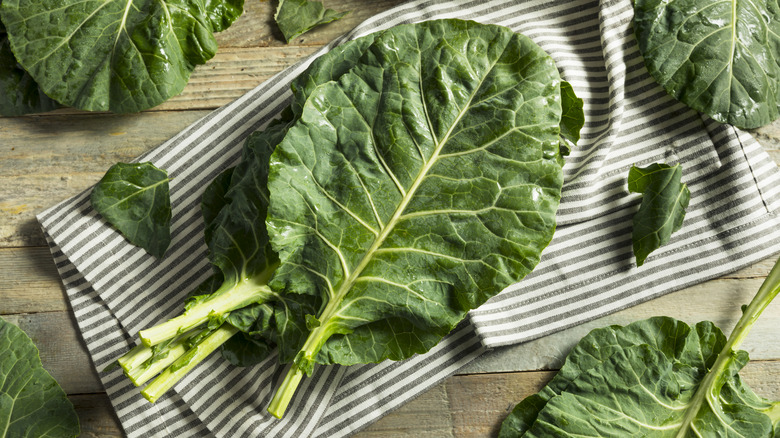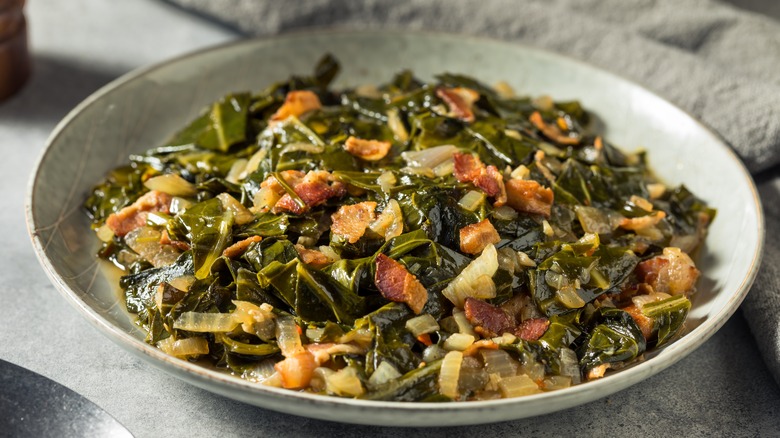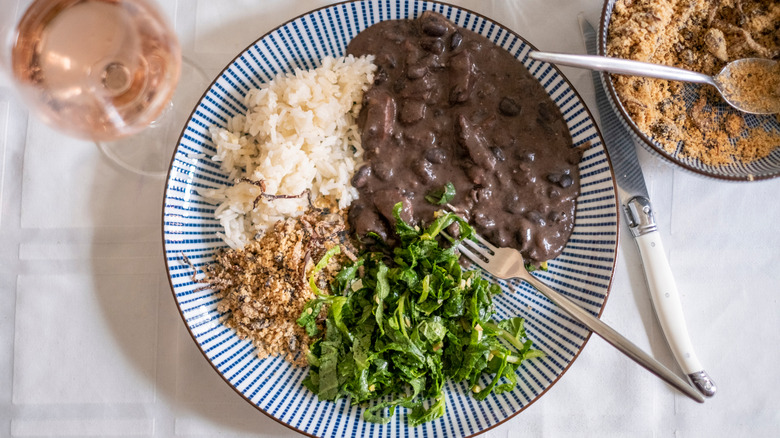How To Fix The Bitter Taste In Collard Greens
When prepared correctly, collard greens are flavorful, hearty, and delicious, but they have an inherently bitter flavor that can be unappealing to some of us. These greens are part of the Brassicaceae family, meaning some of its siblings are other assertive green veggies, like Brussels sprouts, kale, and broccoli. That bold taste allows these vegetables to stand up to smoky flavors, meaty additions like bacon or sausage, and lots of spices. However, if you dress up collard greens a whole lot and still find their bitterness too strong, there are ways to counteract it.
One way to get a handle on the bitterness of collard greens is to buy the right kind. Collard greens like cold weather, and their taste can even be improved by frosty or snowy conditions. In hot weather, however, this vegetable has a tendency to bolt, or suddenly finish its life cycle. Bolting greens can become acutely bitter, while the texture toughens. All collard greens have some level of bitterness, but heading to the farmers' market and seeking out leaves from a young, tender, cold-weather harvest will give you less bitterness overall.
On the other hand, vegetables available in standard supermarkets can come from all over the world, so if that is where you usually shop, you'll have less intel on how the plant was grown. Still, there are a few strategies you can employ to tamp down those strong flavors and make collard greens more enjoyable for sensitive palates.
How to cook collard greens and dilute the bitterness
The chemicals that give collard greens that distinctive bitter taste are called glucosinolates. If you blanch the greens, some of those compounds will be released into the water. First, separate the leaves from the stems. The more tender part of the stems can be slow-cooked, but the base will likely be too tough and bitter, so cut off and discard it. Wash the greens well to prepare them for cooking.
Next, prepare a large bowl of ice water. Bring a big pot of water to a rolling boil, salt it, and plop the leaves in. Cook for about two minutes and then take the greens out and submerge them in ice water. You can use the blanched leaves in a collard greens frittata, fried rice, stews, soups, pasta, and more.
You can also braise collard greens, a technique that is popular across the African continent as well as the Americas. To make braised collard greens, start by sautéing aromatics. A meaty base like salt pork or slab bacon is traditional, but you can create a vegetarian version using dried mushrooms, tomato paste, liquid smoke, or peanut butter. The latter ingredient is popularly used in Zimbabwe. Cook the greens over low heat in water, stock, or ham hock broth. The collard greens will become velvety-smooth, and the bitterness will be diluted into the liquid to create an ultra-flavorful broth called the potlikker (or pot liquor).
Use bold flavors to balance bitterness
You can also balance out bitter collard greens with the right seasonings. Saltiness, sweetness, spiciness, and acidity can all help to add some balance. Salt is a must-have, no matter what dish you're making, but consider adding other salty and savory ingredients like anchovies, mustard, Worcestershire sauce, soy sauce, bacon, or sausage. Sweetness can be used in the same way. A spoonful of sugar in a collard greens stew or soup helps round out the flavors, and sweet produce like carrots, winter squash, or sweet potatoes are a lovely pairing with the bitter greens.
Strongly-flavored seasonings like chilies, red pepper flakes, cumin, coriander, and smoked paprika are also a nice foil to the greens, as are aromatics like garlic, ginger, onions, shallots, and scallions. If you're using collard greens with a sauce, dressing, or as a braise, add acid in the form of vinegar, tomatoes, or citrus juice to balance out the taste.
Lastly, if you aren't planning on cooking the greens for very long, consider cutting them into thin ribbons to help tenderize the leaves and make their texture and flavor less assertive. For a salad, massage the ribbons with oil like you would with tough greens like kale, and pair with a tangy and salty vinaigrette using ingredients like anchovies, Dijon mustard, lemon juice, white wine vinegar, or a bit of honey. Finish with shaved parmesan cheese and spiced roasted nuts for a delicious and balanced dish.



